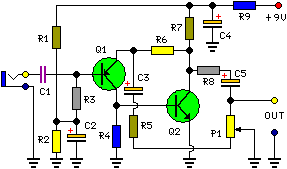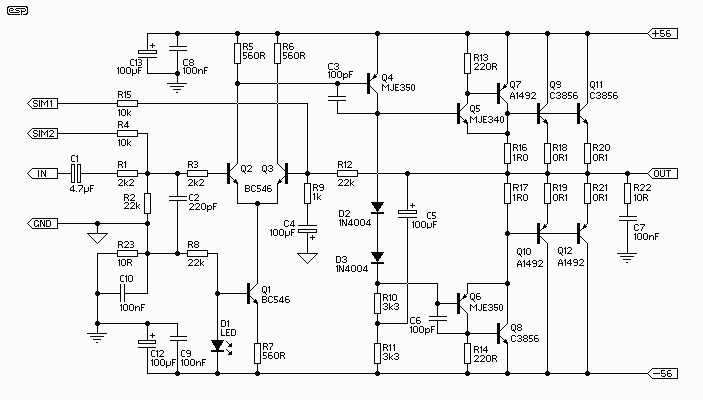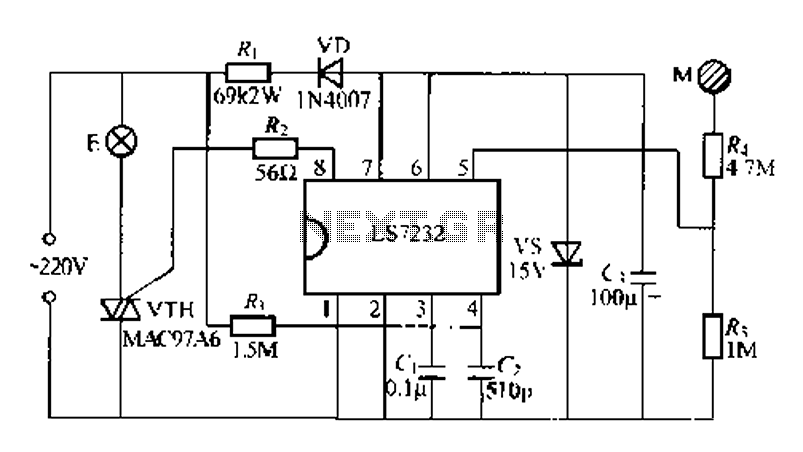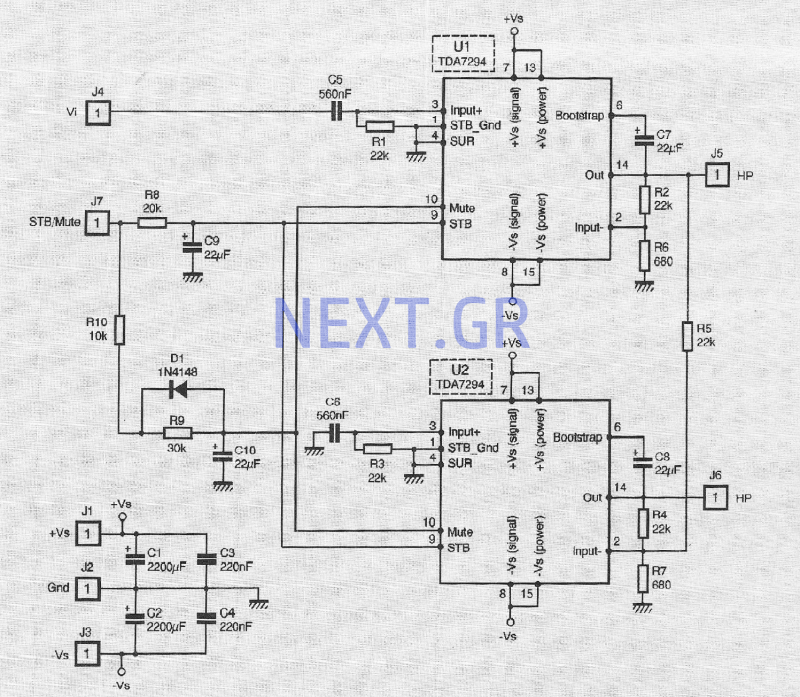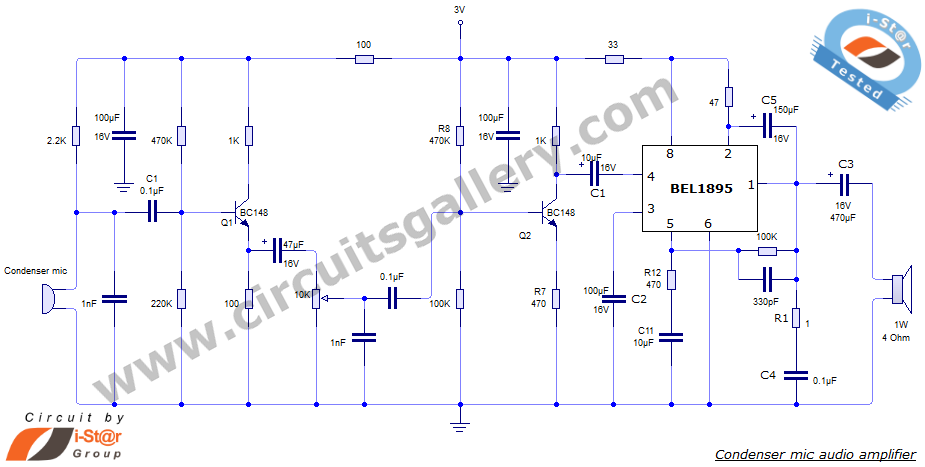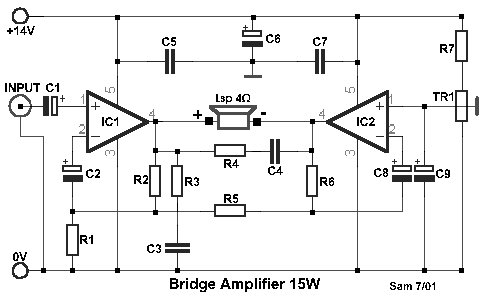
Hybrid Headphone Amplifier
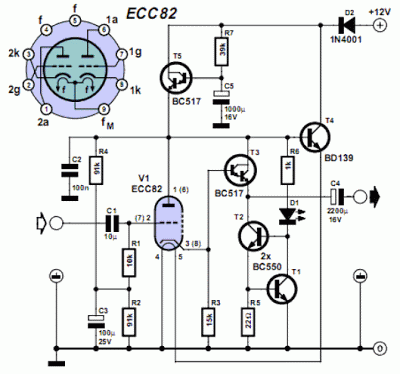
Headphone listening can be technically superior because it eliminates room reflections and allows for an intimate connection between the transducer and the ear, requiring only minimal power. This low power requirement enables transducers to operate at a fraction of their full excursion capabilities, thereby reducing total harmonic distortion (THD) and other nonlinear distortions. The design of a dedicated headphone amplifier can be controversial as it features unity voltage gain and incorporates both valves and transistors. Typical headphones have an impedance of 32 ohms per channel. The standard line output of 775 mV, which high-quality equipment typically aims for, produces a power of U²/R = 0.775²/32 = 18 mW per channel across such headphones. Sensitivity of available headphones ranges from 96 dB to 103 dB/mW, indicating that the circuit requires unity gain to achieve high volume levels. A unity gain design allows for the use of a low distortion output stage, with the emitter follower being a common choice due to its near-unity gain and substantial local feedback. However, the output impedance of an emitter follower is influenced by the source impedance, which can lead to slight variations in sound quality. This circuit design uses a constant low impedance to drive the high impedance of the output stage, which helps maintain low overall THD. Given the moderate output power needed, a Class A circuit is suitable, utilizing a single-ended output stage comprising T3 and a constant current source formed by T1 and T2. The constant current is determined by the Vbe voltage of T1 across R5, setting the current at 27 mA. T3 operates in emitter follower mode, providing high input impedance and low output impedance. The challenge with using a valve at low voltages is achieving adequate current drain without causing distortion, which is addressed by the choice of output device. A BC517 is selected for T3 due to its high current gain of 30,000 at 2 mA. The low impedance output stage allows for capacitive coupling to the load via C4. Although some purists may prefer not to use an electrolytic capacitor for this purpose, the distortion from capacitive coupling is significantly lower than that from transformer coupling. The remaining circuitry conditions the various voltages in the circuit. To achieve a linear output, the valve grid must be biased at half the supply voltage, which is accomplished by the voltage divider formed by R4 and R2. Input signals enter the circuit through C1 and R1, with R1 defining the input impedance. C1 is chosen to have a sufficiently large value to ensure response down to 2 Hz. Although the circuit effectively rejects line noise due to the high impedance at V1's anode and T3's collector current, additional measures are taken to ensure a silent background when no signal is present. This is facilitated by a capacitance multiplier circuit built around T5, another BC517, which avoids loading the filter composed of R7 and C5. The capacitance of C5 is effectively multiplied by the gain of T5, resulting in a low impedance output at its emitter. An important benefit of this design is that the supply voltage is applied gradually when powering up, thanks to the time constant introduced by the circuit components.Potentially, headphone listening can be technically superior since room reflections are eliminated and the intimate contact between transducer and ear mean that only tiny amounts of power are required. The small power requirement means that transducers can be operated at a small fraction of their full excursion capabilities thus reducing THD and o
ther non-linear distortions. This design of a dedicated headphones amplifier is potentially controversial in that it has unity voltage gain and employs valves and transistors in the same design. Normal headphones have an impedance of 32R per channel. The usual standard line output of 775 mV to which all quality equipment aspires will generate a power of U2 / R = 0.
7752 / 32 = 18 mW per channel across a headphone of this impedance. An examination of available headphones at well known high street emporiums revealed that the sensitivity varied from 96 dB to 103db/mW! So, in practice the circuit will only require unity gain to reach deafening levels. As a unity gain design is required it is quite possible to employ a low distortion output stage. The obvious choice is an emitter follower. This has nearly unity gain combined with a large amount of local feedback. Unfortunately the output impedance of an emitter follower is dependent upon the source impedance. With a volume control, or even with different signal sources this will vary and could produce small but audible changes in sound quality.
This device, as opposed to a transistor configuration, enables the output stage to be driven with a constant value, low impedance. In other words, the signal from the low impedance point is used to drive the high impedance of the output stage, a situation which promotes low overall THD.
At the modest output powers required of the circuit, the only sensible choice is a Class A circuit. In this case the much vaunted single-ended output stage is employed and that comprises of T3 and constant current source T1-T2. The constant current is set by the Vbe voltage of T1 applied across R5 With its value of 22R, the current is set at 27 mA.
T3 is used in the emitter follower mode with high input impedance and low output impedance. Indeed the main problem of using a valve at low voltages is that it`s fairly difficult to get any real current drain. In order to prevent distortion the output stage shouldn`t be allowed to load the valve. This is down to the choice of output device. A BC517 is used for T3 because of its high current gain, 30, 000 at 2 mA! Since we have a low impedance output stage, the load may be capacitively coupled via C4. Some purists may baulk at the idea of using an electrolytic for this job but he fact remains that distortion generated by capacitive coupling is at least two orders of magnitude lower than transformer coupling.
The rest of the circuitry is used to condition the various voltages used by the circuit. In order to obtain a linear output the valve grid needs to be biased at half the supply voltage. This is the function of the voltage divider R4 and R2. Input signals are coupled into the circuit via C1 and R1. R1, connected between the voltage divider and V1`s grid defines the input impedance of the circuit. C1 has sufficiently large a value to ensure response down to 2 Hz. Although the circuit does a good job of rejecting line noise on its own due to the high impedance of V1`s anode and T3`s collector current, it needs a little help to obtain a silent background in the absence of signal. The help` is in the form of the capacitance multiplier circuit built around T5. Another BC517 is used here to avoid loading of the filter comprising R7 and C5. In principle the capacitance of C5 is multiplied by the gain of T5. In practice the smooth dc applied to T5`s base appears at low impedance at its emitter. An important added advantage is that the supply voltage is applied slowly on powering up. This is of course due to the time 🔗 External reference
ther non-linear distortions. This design of a dedicated headphones amplifier is potentially controversial in that it has unity voltage gain and employs valves and transistors in the same design. Normal headphones have an impedance of 32R per channel. The usual standard line output of 775 mV to which all quality equipment aspires will generate a power of U2 / R = 0.
7752 / 32 = 18 mW per channel across a headphone of this impedance. An examination of available headphones at well known high street emporiums revealed that the sensitivity varied from 96 dB to 103db/mW! So, in practice the circuit will only require unity gain to reach deafening levels. As a unity gain design is required it is quite possible to employ a low distortion output stage. The obvious choice is an emitter follower. This has nearly unity gain combined with a large amount of local feedback. Unfortunately the output impedance of an emitter follower is dependent upon the source impedance. With a volume control, or even with different signal sources this will vary and could produce small but audible changes in sound quality.
This device, as opposed to a transistor configuration, enables the output stage to be driven with a constant value, low impedance. In other words, the signal from the low impedance point is used to drive the high impedance of the output stage, a situation which promotes low overall THD.
At the modest output powers required of the circuit, the only sensible choice is a Class A circuit. In this case the much vaunted single-ended output stage is employed and that comprises of T3 and constant current source T1-T2. The constant current is set by the Vbe voltage of T1 applied across R5 With its value of 22R, the current is set at 27 mA.
T3 is used in the emitter follower mode with high input impedance and low output impedance. Indeed the main problem of using a valve at low voltages is that it`s fairly difficult to get any real current drain. In order to prevent distortion the output stage shouldn`t be allowed to load the valve. This is down to the choice of output device. A BC517 is used for T3 because of its high current gain, 30, 000 at 2 mA! Since we have a low impedance output stage, the load may be capacitively coupled via C4. Some purists may baulk at the idea of using an electrolytic for this job but he fact remains that distortion generated by capacitive coupling is at least two orders of magnitude lower than transformer coupling.
The rest of the circuitry is used to condition the various voltages used by the circuit. In order to obtain a linear output the valve grid needs to be biased at half the supply voltage. This is the function of the voltage divider R4 and R2. Input signals are coupled into the circuit via C1 and R1. R1, connected between the voltage divider and V1`s grid defines the input impedance of the circuit. C1 has sufficiently large a value to ensure response down to 2 Hz. Although the circuit does a good job of rejecting line noise on its own due to the high impedance of V1`s anode and T3`s collector current, it needs a little help to obtain a silent background in the absence of signal. The help` is in the form of the capacitance multiplier circuit built around T5. Another BC517 is used here to avoid loading of the filter comprising R7 and C5. In principle the capacitance of C5 is multiplied by the gain of T5. In practice the smooth dc applied to T5`s base appears at low impedance at its emitter. An important added advantage is that the supply voltage is applied slowly on powering up. This is of course due to the time 🔗 External reference
